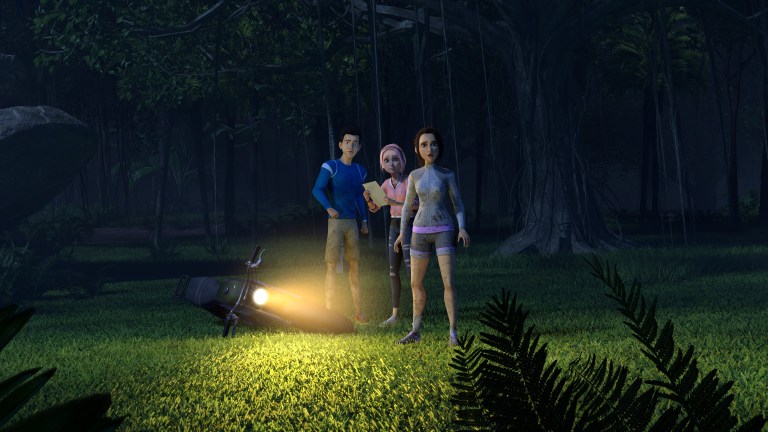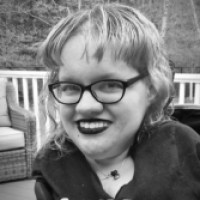Camp Cretaceous Reveals the Real Monsters of Jurassic World
What the emotional evolution of the dinosaurs in the Jurassic Park and Jurassic World franchise can teach us about monsters.

This article contains spoilers for Jurassic World: Camp Cretaceous season 2 and the Jurassic franchise at large.
Our first introduction to Jurassic Park and its dinosaurs is on a dark and misty night, Men wait with guns as the crane crashes through the forest carrying a Velociraptor we are only allowed glimpses of. Tension hangs in the air. When she tries to escape, there are cries of “Shoot her! Shoot her!” The raptor attacks, and rest in peace Jophery, first victim of the monster.
If this scene tells us anything, it is that we are undoubtedly watching a monster movie. And Jurassic Park is. Throughout the first film in this now-lengthy franchise, characters are eaten and dismembered and terrorized as the result of the monsters running free and doing whatever they want with no regard for human safety. Yet, many years later, in the second season of Jurassic World: Camp Cretaceous, it’s so easy to sympathize with the carnivorous Baryonyx pair when their pack mate is fatally shot by a big game hunter. And didn’t we all cry at the end of Jurassic World: Fallen Kingdom when Blue the Velociraptor makes the heartbreaking decision to leave her human friend?
Why wouldn’t the Baryonyx eat our favorite campers if given the chance? Isn’t Blue just as much a predatory monster as the raptors that stalked the kids in the kitchen? Yes and no. The franchise has evolved. Its dinosaurs are absolutely predators, just like the raptors and the tyrannosaur from the first movie, but none of them are monsters. Because the real monsters of the Jurassic series aren’t the dinosaurs. They’re the people.
The Lost World Sets the Change in Motion
The first Jurassic Park incident was triggered by Dennis Nedry (Wayne Knight), a bumbling employee trying to steal dinosaur embryos for a rival company, but it’s The Lost World that gives us our first proper bad guys. The Lost World catches a lot of flack, but this 1997 sequel is where the filmmakers started teaching us to care about the dinosaurs.
The Lost World sees Ian Malcolm (Jeff Goldblum) struggling to balance his responsibilities as a father while also trying to rescue his girlfriend Sarah Harding (Julianne Moore) from Isla Sorna, a second island full of dinosaurs. Not that Sarah really wants rescuing; she’s perfectly content to risk her life trying to pet the young Stegosaurus she’s trying to photograph, even if Mama Stegosaurus doesn’t take too kindly to that kind of thing.
But they aren’t alone on the island. Peter Ludlow (Arliss Howard) and his big game hunting buddies intend to capture dinosaurs living in the wild on the abandoned island and transport them to John Hammond’s latest terrible idea: Jurassic Park San Diego. Other than being jerks, what makes them irredeemably villainous?
They hurt a baby Tyrannosaurus. A baby, you guys. That’s Cruella Deville level evil. It’s this, in a movie revolving entirely around Ian Malcolm’s family, that purposely parallels the dinosaurs with the humans. Yes, they are still dangerous, they still cause death and destruction, but everything they do after Ludlow takes the baby? It’s because he takes the baby. After that, we see their actions through a different lens. They aren’t just killing machines; they are parents, they have feelings, and we can sympathize with that. We can’t help but sympathize with that.
Jurassic Park III Continues the Trend
The third installment, 2001’s Jurassic Park III, reinforces the idea that the dinosaurs are more than instinct driven predators. The Velociraptors in this movie, like our heroes Paul (William H Macy) and Amanda Kirby (Téa Leoni), just want to find their offspring, and they will do whatever it takes to reunite their families.
For the human characters, this means scheming and scamming their way onto Isla Sorna with paleontologist Alan Grant (Sam Neill) in a search for their son, who has been missing for two months after Amanda Kirby’s boyfriend’s attempt at seeing the dinosaurs resulted in a parasailing accident. For the dinosaurs, it means stalking and setting traps to catch the human who stole their eggs with the intention of selling them to fund paleontological digs.
One of the more dramatic scenes in the movie comes when the raptors have surrounded the humans and are demanding the return of their eggs. The mother raptor goes to Amanda, sniffing and nudging the terrified woman for evidence of the eggs. She has identified a fellow female, and though the threat of violence is in the air, there is no indication that the raptors intend to hurt anyone so long as she gets her babies back.
In the original Jurassic Park, having a Velociraptor face on your face would be a death sentence, but here it could be interpreted as more of a terrifying interspecies bonding moment. But then, the original Jurassic Park was a monster movie.
Jurassic World and Camp Cretaceous Drive the Message Home
Every installment in the Jurassic Park franchise, from the first movie to the Netflix animated series Jurassic World Camp Cretaceous, pits humans against dinosaurs in the ultimate example of man versus nature. Except… cloned dinosaurs are hardly natural, especially when they are the hybrids created in Jurassic World and its sequel, Fallen Kingdom. The Indominus rex and her spiritual successor, the Indoraptor, were created purely to sell tickets, to make money, and just to see if it was possible.
You know. Just like all the other dinosaurs in all the other movies.
Blue, the Velociraptor from Jurassic World, is clearly special. She’s smarter than any other dinosaur we’ve seen, and baby footage shown in Fallen Kingdom reveals that she has always had the capacity to feel compassion and concern for her human trainer Owen Grady (Chris Pratt). So it should be no surprise that she is one of the good guys during the final battle with the Indominus. When the Tyrannosaurus, the very same one who terrorized the characters in the first movie, joins the fight alongside Blue, however, that puts things into perspective. It’s not the dinosaurs that are the problem.
Every death, every rampage, every teenage camper stranded on an island after a hybrid wreaked havoc on a park that never should have opened – they were all preventable because they were all caused by people. If John Hammond had spared a little more expense, if the hunters hadn’t injured the baby, if Amanda Kirby’s boyfriend hadn’t felt entitled to a glimpse at the dinosaurs, if Simon Masrani and Benjamin Lockwood had learned from Hammond’s mistakes, if anyone…anyone, had displayed a little more humility in the face of nature and been more preoccupied with whether they should instead of whether they could, none of this had to happen.
The dinosaurs in Jurassic Park are often monstrous, but the real monsters are the people who created them.
Subscribe to Den of Geek magazine for FREE right here!
